




Jillian's Guide to Black Holes: Forming - Types - Outside - Inside - Finding - References - Websites
Looking for what you can't see
Question: How do you go looking for something that is by nature impossible to see?
Answer: By looking for its effects rather than looking directly for it.
For a long time black holes were considered only in the theoretical sense, as an astrophysicist's mental play-thing, instead of something that could exist (especially so frequently). When astronomers say something is suspected to be a black hole, it is not because they went looking for extreme gravitational fields. They label it 'black hole' because that's the only thing it could possibly be: not star, not dead star, not a combination of stars. In manner like Sherlock Holmes, astronomers eliminate the impossible and consider whatever explanations are left.
In astronomy distinction is made between "little" black holes, those with only a few tens of times the mass of the Sun, and supermassive black holes, those with millions and sometimes billions of times the mass of the Sun. First I will describe these little black holes, sometimes called microquasars. Then I will move on to talk about the supermassive black holes, starting with the one at the center of our own galaxy and moving on to those in other galaxies (including quasars!). Lastly, aside from the inherent coolness of it, studying quasars tell us about the state of the universe across time.
"Small" black holes in the Milky Way
There is an entire field of astronomy devoted to studying X-ray sources in the sky. When the first X-ray detector was launched on a rocket, astronomers thought the only X-ray sources in the sky would be the Sun and the Moon (illuminated by the Sun). They were quite surprised when they detected another source, labeled Sco X-1 (meaning "first X-ray source in the constellation Scorpius"). Since then countless objects have been discovered! This first mysterious X-ray source was quite a conundrum to astronomers, though. What could make something that hot? As it turns out, they were seeing a binary system with a neutron star stealing material from another star. Many other binary stars have been discovered, and some of these seem to host black holes. How does this work; how do these binaries emit X-rays?
Let's take the case of a black hole binary. As I explained in the Outside section, black holes can form in binary star systems. Two massive stars can form a binary star system, where they orbit about each other. When one star dies and forms a black hole, it can tidally distort the other star and steal gas from its surface. The gas streams toward the black hole to form an accretion disk of fast-moving, swirling gas. Actually, I say "gas" but at this point the gas is so hot that electrons are ripped off of atoms left and right, so the material is more accurately described as a plasma (which is a fancy way of saying a soup of charged particles). How hot? Millions of degrees Fahrenheit and Celsius. Hot objects emit light, and the hotter the object the shorter the wavelength (and higher the frequency) of light it emits. A stove-top heating coil will glow a sullen red, the somewhat hotter wire filament in a light bulb glows white, and very hot air heated by an arc welder glows bright blueish. These are examples of hot things glowing in visible light (the light our eyes detect). The plasma in an accretion disk is so hot it glows in X-rays, much shorter wavelength and higher energy than visible light.
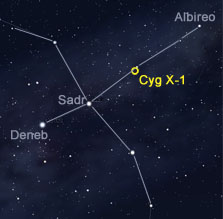 Sky chart courtesy of Stellarium |
Stars of all types are so far from the Earth that, even with the most powerful telescopes, astronomers only see them as points of light rather than resolved (like we see our Sun). However, astronomers are very good at getting the most information out of light that they can (they have to be --- most of the time they can't visit the objects they study).
Let's look at Cyg X-1, a binary with a black hole and a supergiant star. The name means "the first X-ray source found in the constellation Cygnus." This is a famous black hole system in our galaxy. It is 7.4 x 1016 kilometers (4.8 x 1016 miles) from Earth, and light takes over 8,000 years to get from Cyg X-1 to us! To the right is a diagram of the constellatin Cygnus, the Swan, with the location of Cyg X-1 marked by a yellow circle.
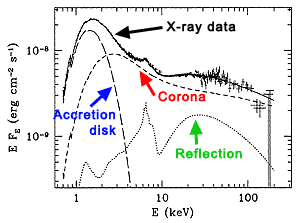 X-ray spectrum of black hole X-ray binary Cyg X-. The data were fit with a model that has multiple parts: the hot accretion disk, a thin and hot corona around the accretion disk, and light reflected off the accretion disk. Image credit Gierlinski et al. (1999) |
You can't see Cyg X-1 with your eyes. You can't even see the supergiant star the black hole orbits with an amateur telescope. Why not, aren't supergiant stars really bright? It's true the supergiant is over six times more luminous than the star Deneb (and over 360,000 times more luminous than our Sun). However, Cyg X-1 is so much further away that it appears almost 1,200 times fainter than Deneb.
The best way to see Cyg X-1 is to look at it with X-ray vision, and this requires using a telescope in space like Chandra! What would we see if we looked at Cyg X-1 with the Chandra X-ray observatory? Well ... a fuzzy dot. Only looking at a picture won't tell us the whole story; we need to make a graph! Astronomers love graphs, since they can show complicated information in useful way. To the left is a plot of the how bright Cyg X-1 is in X-rays and gamma rays. The vertical axis represents brightness and the horizontal axis represents the energy of light (higher energy light is on the right while lower energy light is on the left).
The "fuzzy" black points labeled 'X-ray data' represent how bright Cyg X-1 is at each frequency of light. It is the brightest around 2 keV and has emission all the way up to 100 keV. A line connecting each data point has a curve with a hump-shape. What can we learn from this? Astronomers can calculate how bright an accretion disk should be at different frequencies of light, depending on how hot the disk is. They can also model other kinds of light the disk would emit.
When the components of this model are added together, they make a curve that lines up with the data. What can't astronomers add any combination of models to match the data? Well, these models are based on the size, composition, temperature, etc. of the accretion disk, and also affected by the mass of the black hole. At the end of the day, the model has to make sense and it has to agree with the observations. The model that best matched the data for Cyg X-1 requires a black hole 12 times the mass of the Sun. Using a different black hole mass would create a different model that wouldn't match the data as well. This is one way astronomers can determine the mass of a black hole in a binary system! This is also a way to tell if a binary has a black hole or a neutron star in it: neutron stars cannot be more massive than 2 or 3 times the mass of the Sun; so if you find something that is 10 times the mass of the Sun, it has to be a black hole.
The model is plotted as a solid black line and is hard to see because it lies directly on top of the data - a good fit! This model was made from three parts. The light the accretion disk emits is shown by the long-dash line (and labeled in blue). There is also something called a corona, and much like the corona of our Sun it is a region of hot gas that is much less dense than the accretion disk; the light this corona emits is shown with the short-dash line (and labeled in red). The third component is the light the accretion disk reflects from the hot inner parts; its emission is shown with the dotted line (and labeled in green). Why is it so complicated and pointy? This reflects (aha, a pun) the different kinds of material in the accretion disk.
This model is good but not perfect. The data just beyond 100 keV don't fall on the model line. That implies that there's more science going on! Perhaps the astronomers need to add another component to their model. If you recall from the Outside section, I mentioned that an accretion disk can launch jets of fast-moving particles. Just as physics tells us how bright a hot object is at different frequencies, astronomers can calculate how bright a jet would be. Actually detecting this jet is tough, though, since the accretion disk is very bright by comparison. There are certain frequencies (or wavelengths) of light where the jet stands out the most: very high-energy X-rays, infrared, and radio. (Want a refresher on the types of light?).
Jets were first noticed in the radio. Why radio? If you just look at the binary, nothing else in the binary system (accretion disk, corona, star being mooched off of) gives off much radio emission. Seeing radio emission from one of these objects would stand out as weird to an astronomer, and make them look a little closer. Also, radio telescopes also have good resolution and can see small features; and radio light isn't blocked by dust and gas as much as optical light is (think of the dark dusty parts in the Milky Way in the night sky!). Radio telescopes have a better chance of detecting more jets from further away!
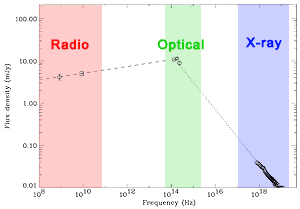 Multiwavelength spectrum of black hole X-ray binary GX 339-4. The data were fit with a model (dashed and dotted lines) to show that emission in the X-ray, infrared and optical, and radio could be explained by a jet. Image credit Corbel & Fender (2002) |
Jets are very small and far away, so most of the time astronomers can only see the source as a little point of light rather than an extended object. How do you know a jet is there if you can't see it sticking out of the binary? To the left is a graph of another black hole binary, GX 339-4. What's with the name? Well, after you start finding more and more X-ray sources, naming them So-and-So X-next-number-in-the-list gets awkward. Astronomers switched to catalog names, especially for all of the objects discovered by individual X-ray satellites.
Back to the graph. Just like in the previous graph, brightness is plotted in the vertical direction, and frequency of light is plotted in the horizontal direction (again, higher energy light on the right side and lower energy light on the left side, high frequency light on the right side and low frequency light on the left side). This graph has a wider range of frequency than the previous one I showed you: radio is low frequency light, optical is higher frequency than radio, and X-rays are even higher frequency. These obsevations were made with multiple telescopes looking at GX 339-4 all at the same time. This is tough to arrange, but it is worth the science!
Just as physics tells us how bright a hot object is at different frequencies, astronomers can model how bright a jet a should be at different wavelengths. The emission from GX 339-4 at these particular frequencies was best fit with a model of jet emisssion. Wait, where's the accretion disk? The emission from the disk isn't shown on this graph, but it would be in the X-ray portion, just to the left of the plotted data.
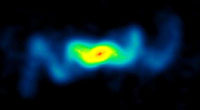 A false-color image of the twin radio jets from the black hole X-ray binary SS 433. Image credit Blundell & Bowler, NRAO/AUI/NSF. |
While astronomers love graphs, they can be a bit dull, right? I mentioned that it's easier to deduce a jet's presence than to take a picture of it, but there are a few pictures of jets from black hole binaries. The most spectacular image is that of SS 433, shown to the right. This is an image taken in radio light of two fantastic cork-screw jets from a black hole binary. The color code represents brightness, with red being very bright and blue being not at all bright; so you can see that the jets are dim compared to the black hole binary itself (specifically, compared to the accretion disk, which is responsible for most of the light from the binary).
A final note: stellar-sized black holes ("small" black holes) are sometimes called "microquasars", since they resemble quasars but are much less massive. What's a quasar? Well, first I should talke about the "large" black holes, called "supermassive" black holes.
Supermassive black hole in the Milky Way
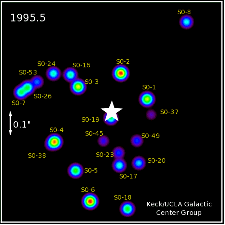 Fifteen-year movie of the stars orbiting the black hole at the center of the Milky Way (indicated with a star shape at the center of the image). Image credit Keck/UCLA Galactic Center Group |
Aside from stellar mass black holes, there are also monsters that are millions and billions of times the mass of the Sun. These are called supermassive black holes. The closest one to us is referred to as Sagittarius A* (pronounce that last bit as "a star"), located at the center of the Milky Way galaxy. Why would anyone suspected a million mass black hole at the center of the Milky Way? It started with radio observations in 1974 of strong emission toward the galactic center. What could cause this emission? Hot gas? If so, what was heating it? Over time, and with more observations, it became clear that this mysterious object was massive (a few million times the mass of the Sun!) and very small (about the size of the Earth's orbit!).
What if this massive thing were just a very large cluster of stars that was hidden somehow? There is a lot of gas and dust between the Earth and the center of the Milky Way, so a lot of optical light is blocked. However, gas and dust doesn't block infrared light as much, so by using infrared telescopes astronomers were able to see through this screen and study the galactic center. What they found is that there are stars but no groups large enough to account for all of the mass. Two groups (Ghez et al. 2008 and Gillessen et al. 2009) studied the motions of stars around something massive and dark for 16 years! These amazing long-term studies reveal that the stars all appeared to be orbiting around something invisible with the mass of 4 million Suns.
The animation to the right shows the positions of stars at the very center of the Milky Way from 1995 to 2010. The location of the supermassive black hole is marked with a light blue star shape. As time progresses, the stars are seen to move in orbits around something. The behavior of things in orbits has been studied as far back as the 1600s, and students of undergraduate astronomy classes will tell you that their teachers belabored Kepler's Laws of Motion endlessly. The point is, if we see something (some gas, a Moon, a planet, a star, etc.) orbiting an object, physics tells us how massive that object is. By carefully observing these galactic center stars, astronomers were able to determine the mass (4 million times the mass of the Sun) and the distance (8.3 parsecs, meaning light takes 27,000 years to get to us from the center of the galaxy) to the supermassive black hole at the heart of the Milky Way.
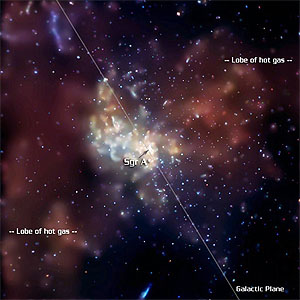 X-ray image of the area around Sag A* taken by the Chandra satellite. Image credit NASA/CXC/MIT/F.K.Baganoff et al. |
Wait, if there's a black hole at the Milky Way's center, shouldn't it have a bright, bright accretion disk around it? Not always. The "small" (stellar mass) black holes in the Milky Way tend to found in binaries and usually when they are actively stealing material from their partners. While formation of a surpermassive black hole is still being studied, they don't form with such a nearby "bank" of gas for convenient steady "withdraws" as their stellar cousins. Such is the case with Sag A*. Radio, IR, and X-ray emission suggests that Sag A* does have an accretion disk and material is falling into the black hole. However, this activity is quite mild, and some even called our supermassive black hole "starved".
While Sag A* is quiet now but it wasn't always so in the past. By studying the gas clouds at the galactic center, astronomers can find out what Sag A* was doing in the past, like a combination of studying a fossil record and figuring out what someone ate by looking at the crumbs on their table. How does this work?
Astronomers noticed X-ray emission from two huge lobes of hot gas (20 million degrees!) surrounding Sag A* (the red-colored gas shown in the image to the left), implying that the black hole was busy gulping down gas ~10,000 years ago. The X-rays emitted by the gas falling into the black hole heat up the gas that's still around the black hole. A lot of gas falling into the black hole would really heat up the surrounding gas, making it puff up and be less likely to get near the black hole. In this way black holes are like messy eaters that push away the very "food" they want to "eat".
Supermassive black holes in other galaxies
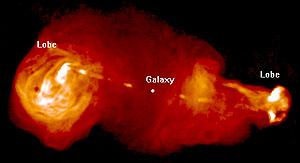 A false-color image of a radio galaxy, 3C 353. Image credit NRAO/Swain, Bridle, Baum. |
While the supermassive black hole at the center of the Milky Way is "quiet", astronomers have seen some at the centers of other galaxies that are not. Some of these supermassive black holes are active with accretion disks and jets, shining bright in radio and X-rays. Some are even considerate enough to astronomers to have massive radio jets pouring out of the center of the galaxy like gigantic arrows saying, "ohai --- it's me! I'm a black hole!"
A fine example of this are the impressive jets of radio emission from the galaxy 3C 353 (shown to the right). This image is taken in radio light; when the astronomers made this image, they color-coded it on a white to red color scale (where white means a lot of emission, red means not much, and black means none at all). The actual galaxy is the little dot in the middle of the image. The bright blobs and complex structure at the ends of each jet are probably the jet material plowing into gas that surrounds the galaxy, creating shock waves and slowing down and spreading out the jets.
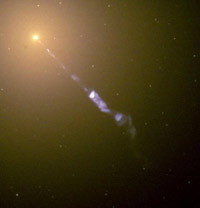 The supermassive black hole at the center of the giant galaxy M87 shots a powerful jet. Image credit NASA and The Hubble Heritage Team (STScI/AURA). |
The most famous black hole in another galaxy would have to be the supermassive one at the center of the giant elliptical galaxy M87. To the left is a Hubble image of the center of M87, where a bluish jet shows up very well compared to the yellowish light of the unresolved stars in the galaxy. The jet is coming from the center of the galaxy. Since the material in the jet is moving near the speed of light and pointing at the center of the galaxy, astronomers expected that it is launched by a supermassive black hole. Powerful telescopes at different wavelengths have been pointed at this monster, zooming in on the jet, resulting in an actual image of the the accretion disk (wow!). While, again, this doesn't show us the event horizon and conclusively prove that it is a black hole, there aren't any other kinds of sources which could be responsible for all of this behavior.
Since other galaxies are so far away, there aren't many other examples of actual images of accretion disks around supemassive black holes. In NGC 6251 astronomers got an image of reflected light off the edge of the disk. Wait, what? Apparently the disk around this black hole is warped, tipped up a little like the brim of a hat. This "brim" reflects light from the center of the disk, which we can't see because the front of the disk is blocking it. Curiously, the dusty disk around the supermassive black hole in NGC 7052 has a radio jet that isn't perpendicular to the dusty disk. Why would that happen? It's possible that the dusty disk is from a galaxy that NGC 7052 absorbed, so that when the dust and gas was funneled to the center of the galaxy, it formed a disk that wasn't quite perfectly aligned with the accretion disk of the supermassive black hole. In astronomy it's sometimes joked that "there aren't any normal [insert object of study]", and this seems especially the case with the complex (messy!) environment at the centers of galaxies.
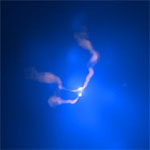 Radio jets (shown as pink) stream out from supermassive black holes in two galaxies (the bright dots) dancing around each other in NGC 1128. Image credit X-ray: NASA/CXC/AIfA/D.Hudson & T.Reiprich et al.; Radio: NRAO/VLA/NRL. |
If the black hole at the center of the Milky Way is quiet, but the black holes at the centers of these other galaxies are clearly quite active, then what's the difference? What causes one galaxy to have bright black hole and powerful jets while another might be dim with no jets?
It seems that when galaxies collide and/or merge, gas is funneled to the centers of the galaxy and that fuels an outburst for the supemassive black hole. Merging galaxy pair NGC 1128 (shown to the right) both sport beautiful jets glowing in radio light (shown as pink light in the image). These two galaxies orbit each other and eventually they will merge into one. They're dancing around each other in a bubble of super-heated gas that glows in X-rays, shown as blue light in the image. This causes their jets to trail slightly as if blown by the wind.
Galaxy pair 3C 321 has what astronomers whimsically call a death star ray. The smaller galaxy orbits the larger one, and it orbited right into the path of the larger galaxy's jet! The jet from the larger galaxy streams out and hits the smaller, neighbor galaxy, causing shock waves that heat the gas at the impact site. This might not be as bad as it sounds, for these shock waves could cause a wave of new stars to be born in the smaller galaxy!
The double core of Markarian 315 provides an example of the end-stages of two galaxies that merged into one (or, rather, one galaxy that ate another one). This galaxy has a jet coming from the center, but when astronomes turned the Hubble telescope to the very center they found two cores! The brighter core is the center of the galaxy and responsible for launching the jet. The other dimmer core is all that remains of a smaller galaxy that Markarian 315 absorbed. This second core is like a hard candy that's been dissolved down to a little sliver: all that remains is the centermost part of the galaxy and its supermassive black hole.
Active Galaxies: Seyferts, blazars, and quasars, oh my!
The growth of galaxies and their black holes is something astronomers can study at various epochs in the universe's lifetime. That's right, astronomers can time travel! Well, okay; they don't actually travel in time, but astronomers can certainly look into the past! How do astronomers look back in time and why are they sure they're looking at a supermassive black hole?
First question: time travel! While the speed of light is very fast, it is not infinite. It takes time for light to travel to us. The further away an object is, the longer it takes for that light to get to us. The longer it takes, the further back in time we see it, since the light that was just emitted right this second is only just beginning the long trek to get to us. By studying more and more distant objects, astronomers are able to study how the early universe appeared. This is called "look-back time", meaning the age the universe was when the light we see was emitted. This makes telescopes like time machines, letting us see further back in time.
Second question: identifying supermassive black holes! What if the galaxy so far away that we can't see jets coming out of the center? There are a few key pieces of evidence which form a "smoking gun" pointing to supermassive black holes: extreme brightness, high temperatures, and quick variations. Let's step through each of these.
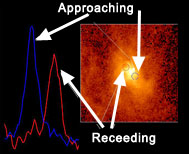 Gas in a disk around the supermassive black hole at the center of M87. Image credit NASA/HST/Ford, Harms et al. (1994). |
Remember when I talked about how the color of light can change depending on whether it moves toward or away from us? Also how material forms an accretion disk before it falls into a black hole? If we look at this accretion disk, we see gas moving toward us on one side and away from us on the other side. How fast is it moving? Astronomers studied the gas at the center of M87 (the image to the right) and found it screaming along at 550 km/s (1.2 million mph)! Physics tells us how gravity works, including how gravity makes objects orbit other objects. The speed of the gas in this accretion disk tells us that there is something truly massive (billions of times the mass of the Sun) at the center! Thus, by using the speed of the gas swirling around the supermassive black hole in an accretion disk, astronomers can "weigh" supermassive black holes! Also, just like with stellar-sized black holes, astronomers can even tell that there's jet based on the kind of light it emits without actually having to see it!
One final but very important piece of evidence is the speed at which these mysterious centers of galaxies can change. A small object can vary faster than a large one, so the speed of variation puts an upper limit on the size of the region doing the emission. Hawaii University Astro 110 has a longer explanation of this, if you click through to slide #17. By studying the speed of variation of these bright central regions with suspected supermassive black holes, astronomers conclude the emission region is about the size of the solar system! That's only slightly larger than the Rs for these supermassive black holes!
At this point I've gotten as tired of typing "supermassive black hole at the center of galaxies" as you might be of reading it, so I'll simplify it to Active Galactic Nucleus, or AGN. Astronomers (like engineers) love acronyms because it helps speed up communication. Not all AGN appear the same, and there are a few different general types that are observed: quasars, Seyferts, blazars, and radio galaxies. I'll describe each one and then discuss the a model that unifies all of them. There are some good summaries of AGN out there on the web, so I suggest you also check out Learning Space (amazing, just wonderful!), Astronomy Online, Ohio State University, Monsters in galactic nuclei.
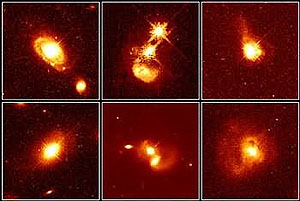 A sample of quasars (showing diffraction spikes) taken in red light by Hubble. Image credit NASA/HST/Bahcall & Disney. |
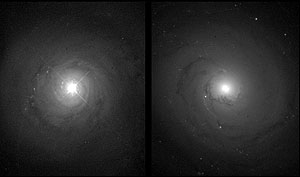 A Seyfert galaxy (left, showing diffraction spikes) compared with a "normal" galaxy (right). Image credit HST/Malkan;Carollo, Stiavelli, and Mack. |
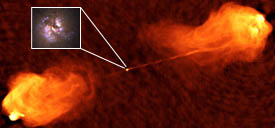 A false-color image of the twin radio jets from the supermassive black hole in the center of the galaxy Cygnus A, which is the small dot in the center of the image. Inset is a zoomed in view of the galaxy itself in optical light. Image credit NRAO/AUI. |
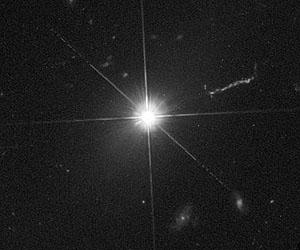 Blazar 3C 273 (showing diffraction spikes) has a jet emitting optical light (upper right hand corner). Image credit NASA/HST/Bahcall. |
Since they are so small and so bright, quasars were initially thought to be just another type of variable star. There are plenty of stars out there that vary in unique ways, and quasars were essentially just bright points, so this was a natural (if ultimately incorrect) conclusion to draw. In 1963 Maartin Schmdt studied the quasar 3C 273 (gotta love these catalog names) and realized that it had emission from hydrogen gas that was greatly redshifted, as if the gas were moving away at 15% the speed of light (about 45,000 km/s or 100,700,000 mph). He also realized that this object wasn't a point of light like a star, it was "fuzzy" like a galaxy. The nature of these objects was quite a mystery, and many people were talking about them. The term "quasar" was coined by Hong-Yee Chiu in 1964 because "quasi-stellar radio source" was unwieldy. It took some time, but eventually it was accepted that quasars were very distant active galaxies whose light is greatly redshifted by the expanding universe.
Now, thanks to the Sloan Digital Sky Survey, more than 200,000 quasars have been identified. Quasar galaxies can be spirals, ellipticals, or irregulars, but the more massive the galaxy the brighter the quasar. The first quasars discovered emitted lots of radio light, but these turned out to be oddballs: only 10% of all identified quasars are actually bright radio sources. By looking at how many quasars are found at what redshift, astronomers discovered that the universe contained the greatest number of quasars was it 1/3 its current age (or about 4.5 billion years old). Why does quasar activity peak around that time? Why aren't there the same number of quasars today? Quasars "turn on" when their supermassive black hole is "feeding", or absorbing material, so it seems these black holes feed in spurts. When galaxies merge, a lot of material gets funneled to the centers, to the supermassive black holes. The black hole has a huge meal but the powerful X-rays and other emission from this feast actually ends up blowing away the rest of the material. This ends the black hole's "meal" and "turns off" the quasar, leaving a more normal galaxy.This implies there were more galaxy mergers when the universe was 4.5 billion years old than there are today, which is confirmed by galaxy surveys.
Seyferts are spiral galaxies (like our Milky Way) or irregular galaxies (small hodge-podge galaxies that don't have a disk-structure) with a very bright core. They usually don't have jets or radio lobes like radio galaxies do, but they do emit gamma rays. The black and white image to left shows two galaxies: the one on the left is a Seyfert galaxy and the one on the right is a "normal" spiral galaxy. Astronomers have detected emission from the very hot plasma in the accretion disk around the black hole. By studying the emission from the accretion disk, and because Seyferts are a fainter kind of quasar, astronomers think the supermassive black holes in Seyfert galaxies are on the small side. Seyferts can be further broken down into two types, based on whether or not we can see the faster-moving and hotter inner part of the accretion disk. In 1943 Carl Seyfert first realized that these galaxies represented an unusual group (or class) of galaxies. In 1965, after the discovery of the true nature of quasars, it was proposed that Seyfert galaxies were also powered by a supermassive black hole.
Radio galaxies are usually elliptical galaxies, which are massive, old, spherical balls of stars that are far larger than the Milky Way; but sometimes they are also merging galaxies. These galaxies all have the distinction of spouting huge jets or lobes of gas which glow brightly in radio, as shown in the image of Cygnus A to the left (also like the images above of 3C 353 or NGC 1128). Sometimes the jets or lobes of radio galaxies are bent or twisted, or they have bright spots at the edges. This is caused by material in the jet running into thicker gas clumps surrounding the galaxy. These impacts create shock waves that heat up the gas, making it glow brighter.
The history of radio galaxies can be told in the amazing story of Cygnus A. After WWII radio dishes were put to new (and more peaceful) uses by astronomers, and radio astronomy was born. In the 1950s it was thought that all radio sources in the sky had to be within our own galaxy. Walter Baade ("bahd-ae") proposed that colliding galaxies could be extra-galactic radio sources and that Cygnus A was one such example. This idea was decried at the time, especially by another astronomer, Minkowski. Baade was confident in his result (and angry at Minkowski for his dismissive treatment at conferences) and bet Minkowski a bottle of strong whiskey that he was correct. It took a series of radio observations to prove the small size of the area emitting all the radio light, and an amazing photo by Baade of the colliding galaxies responsible for Cygnus A --- but finally Minkowski was convinced and the two presented this theory in 1954.
Blazars are a type of quasar, and they tend to be found closer to us than most quasars. Blazars are giant elliptical galaxies with incredibly bright and rapidly variable cores. Seriously, those jets are bright: they are the "most powerful particle accelerator in the universe"! How rapidly do they vary? Compared to other quasars that change over years, blazars can change in a few days! The name "blazar" was coined by Edwin Spiegel in 1978 to describe this peculiar class of quasar: these objects had the properties of a weak class of radio galaxies, called BL Lacs, and a kind of quasar whose optical light is highly variable. Spiegel handily combined "BL Lac-type quasar" into the name "blazar".
Blazars also exhibit something apparently impossible: superluminal motion, that is to say material that seems like it's moving faster than the speed of light! This is actually an optical illusion cause by two things: the jet of the blazar is pointed right at us, and the material in the jet is moving at near-light speeds. These near-light speeds are also responsible for the incredible brightness of a blazar: material that moves at near-light speeds emits all of its light in a narrow beam (like a headlight) in the direction that it's traveling. This "relativistic beaming" behavior is described by special relativity and is also responsible for the jet emission in stellar-sized black holes.
This seems like quite a variety of strange and powerful objects. How can there be one model which unifies them all, especially if each of them seem to have different kinds of light that they emit? The idea is that all AGN have the basic form of a supermassive black hole with an accretion disk, which is in turn surrounded by a large and thick torus (or donut) of gas and dust. This supermassive black hole may or may not be launching a jet.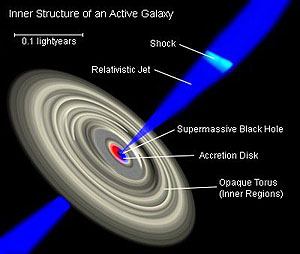 AGN unification model of a dusty torus surrounding the accretion disk around the black hole, with a powerful jet coming from the center. Image credit Galaxy Zoo. |
What distinguishes the different types of AGN is the angle from which we happen to see it:
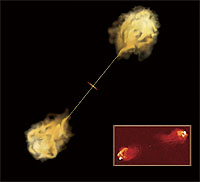 If we looked at this object edge on (straight through the disk), we'd see a radio galaxy, since the torus would block most of the radiation and all we'd see is the jet. |
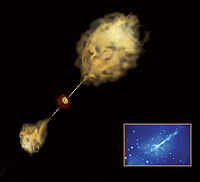 If we looked at some angle between the side and the top, we'd see a Seyfert galaxy or a quasar. The torus of gas and dust absorbs some of the high-energy radiation from the accretion disk and re-emits it as lower-energy radiation. Quasars are a much more active version of Seyferts seen really far away (that is, in the very early universe). Image from this presentation found on Fermi E/PO. |
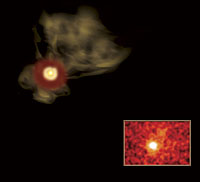 If we saw this object from the top, looking straight down the jet, we would see a blazar. Emission from the jet would be so bright that it would swamp anything else from the accretion disk or the torus. |
What active galaxies tell us about the universe
The take-away point is that, be they quiet or active, merging or single, most galaxies seem to have supermassive black holes lurking at their centers. By studying many of these galaxies, astronomers have learned something interesting: the mass of supermassive black hole is directly related to the mass of galaxy. This means that more massive galaxies have more massive black holes. Why is this strange? Well, for one, most of the galaxy doesn't live under the gravitational thumb of the black hole --- only gas and stars very close to the black hole come under its direct influence. Yet, the connection between the supermassive black hole and its host galaxy can't be denied. Whatever makes galaxies fat also seems to make the supermassive black hole fat.
AGN also tell us about the universe around them. If there is gas between a quasar and the Earth, it absorbs the light at certain wavelengths. Since quasars are so far away, their light is absorbed by many different gas blobs at distances near and far. By studying the pattern of absorption, astronomers can figure out the distance to the gas blob and thus figure out when in the universe's lifetime the gas existed. Astronomers used this information to learn how gas has changed over the time. Why is this gas important? It represents the building blocks of galaxies! There are two important kinds of observations from this gas: the Gunn-Peterson Trough and the Lyman Alpha Forest.
Quasars from more than 12 billion years ago (when the universe was only 950 million years old) show something called the Gunn-Peterson Trough. This "trough" is a dip in the spectrum where all of the UV light emitted by the quasar was completely absorbed by gas next to the quasar. What this tells astronomers is that there was hydrogen gas surrounding the quasar, except it wasn't the ioinzed gas like we see today --- it was completely neutral hydrogen. These quasars tell us about a very early part of the universe's lifetime called "reionization". This is when the very first quasars were just beginning to "turn on", and their light was ionizing all of the neutral hydrogen gas around them.
Quasars from less than 12 billion years ago (after reionization) show something called the Lyman Alpha Forest. The "forest" is a series of dips in the spectrum. These dips are cause by a few remnant clouds of neutral hydrogen absorbing some light. These clouds are at different redshifts, so they absorb different parts of the spectrum. By studying the forest astronomers learn about the state of gas at many points of the universe's lifetime. It's like having a portrait taken every 2 years for many generations of a family!


